My recent visit to Japan included a stop at the garden of one Mr. Iwakiri in Miyazaki, Kyushu. Iwakiri has been growing bonsai for more than 40 years and he has a wealth of knowledge on the topic, particularly when it comes to developing black pine.
As I mentioned a few weeks ago (see “A visit to Miyakonojou“) black pines developed by the seedling-cutting technique can often provide us with too much of a good thing. What to do when we find too many roots resulting from the seedling-cutting technique? Iwakiri has two recommendations:
- If developing anything but small bonsai, don’t use the technique. The seedling-cutting technique can result in overly homogenous roots. Eschewing the technique can allow for more natural looking roots.
- If developing small bonsai using the seedling-cutting technique, remove every other root. Keeping every root can yield more roots than makes sense for small trees and can create large flat root pancakes – a structure that doesn’t look natural for pines and one that makes fitting small trees into appropriately sized pots impossible.
Iwakiri has dutifully removed superfluous roots on his small pines for decades, but to really test the hypotheses, he kept all of the roots on a few trees as a control of sorts. Here’s what happened. At a glance, it appears that keeping all of the roots has produced a very nice root base. Upon greater scrutiny, we can see two problems. The more obvious is that the roots are all the same shape and size – a form rarely seen in nature. The bigger problem is that the root spread is quite large in relation to the base of the trunk. This second issue is more a matter of style and taste than the first, and for that reason I find it the more interesting of the two.
The ratio of trunk to root-base for the control tree is around 4:1. If the trees with larger trunks followed the same ratio, we’d have some humongous root bases. Would this be a problem? Does it depend on the tree? I’ve included photos below of the “control” tree along with some other bonsai from Iwakiri’s garden for comparison.
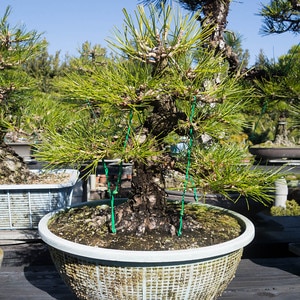
Black pine created via seedling-cutting
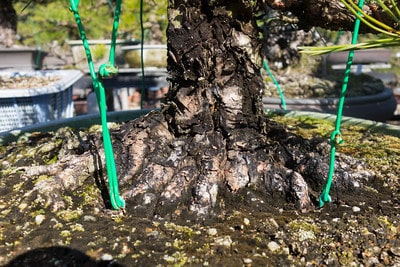
Root base detail – note how similar the roots are
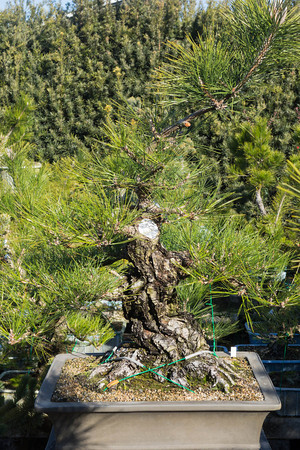
Black pine – around 40 years old
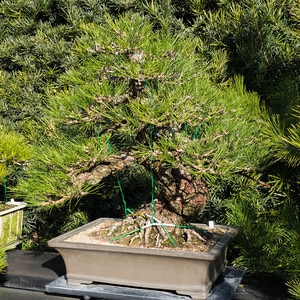
Black pine – 30-40 years old
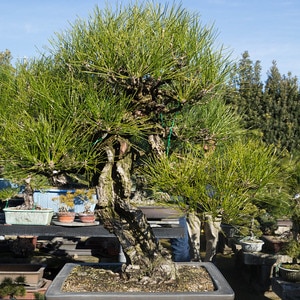
Black pine
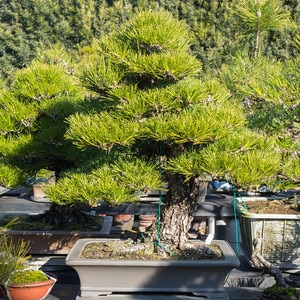
Black pine
Subscribe to Bonsai Tonight
New Posts Delivered Every Tuesday and Friday
Zack Clayton says
Does this make you rethink your seedling cutting or does it not matter for your projected finished size for the trees? Would repotting the control a bit deeper change the appearance enough to make a difference – it looks like there is some size variation about an inch up the trunk from the current soil line. The tree would have needed to be repotted deeper over the life of the tree, but since he started it from scratch it seems possible as a plan.
Jonas Dupuich says
Hi Zack, good question – I was thinking of starting a number of seedlings without making seedling-cuttings to see what happens. Although I’ve had the problem of too many roots on a few trees, one thing that has saved me is that not all trees created by seedling-cutting end up with too many roots. For those that do, I don’t know that planting the tree deeper would make the difference unless I began selectively removing the extra roots along the way – something I’ll do more consciously going forward.
Thanks for asking – I think there will be a lot of fun experiments ahead!
Jeremiah Lee says
Thank you for sharing such important information! I think that you just significantly improved the future of seedling and seedling cutting grown Black Pine in the US. Great Info!
Chris Cochrane says
Mr. Iwakiri makes a very useful point in regard to creating a large, flat, root-spread “pancake.” The front to back diameter could make fitting small trees into appropriately sized, _oblong_ pots impossible.
Lee Bates says
The control seedlings look a lot like pines in nature in my area. There is very little soil with sandstone or limestone rock underneath. The root structure actually elevates the tree as they spread out and then grow in caliper.
mirko says
Thanks for sharing this Jonas Dupuich
Timothy says
Thanks for this!
I guess it is a matter of personal preference. I would find that type of root base desirable.
lawalazeez76 says
thanks a lot for dis beautiful info